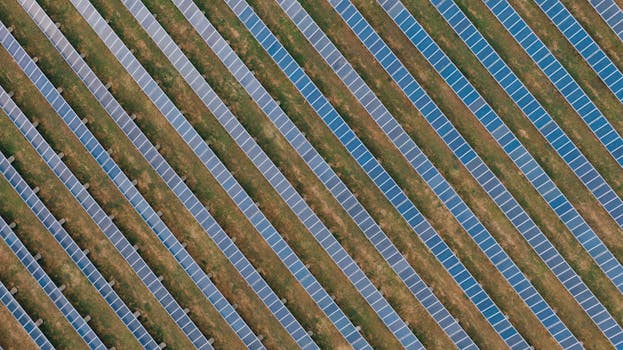“Maximize Your Solar Power: Harness the Sun with Precision Solar Trackers.”
Solar trackers are innovative devices designed to optimize the efficiency of solar energy systems by adjusting the position of solar panels throughout the day. By following the sun’s trajectory, solar trackers can significantly increase energy capture compared to fixed installations. This technology not only maximizes the output of solar panels but also enhances the overall return on investment for solar energy projects. With the growing demand for renewable energy solutions, solar trackers represent a crucial advancement in harnessing solar power, enabling users to unlock the full potential of their solar systems and contribute to a more sustainable future.
Benefits of Solar Trackers for Increased Energy Efficiency
Solar trackers have emerged as a transformative technology in the realm of renewable energy, particularly in enhancing the efficiency of solar power systems. By adjusting the orientation of solar panels throughout the day to follow the sun’s trajectory, solar trackers significantly increase the amount of sunlight captured, thereby maximizing energy production. This dynamic capability is crucial, especially in regions where sunlight is abundant but can be inconsistent due to the angle of incidence.
One of the primary benefits of solar trackers is their ability to boost energy output by as much as 25% to 50% compared to fixed solar panel systems. This increase is largely attributed to the fact that solar panels are most effective when they are perpendicular to the sun’s rays. Fixed installations, while simpler and less expensive, often miss out on optimal sunlight exposure during certain times of the day. In contrast, solar trackers continuously adjust their position, ensuring that the panels maintain an ideal angle relative to the sun, thus capturing more energy throughout the day.
Moreover, the enhanced energy efficiency provided by solar trackers translates into a more favorable return on investment. Although the initial costs of installing solar trackers can be higher than those of fixed systems, the increased energy production can lead to quicker payback periods. This financial advantage is particularly appealing for commercial and utility-scale solar projects, where maximizing energy output is essential for profitability. As energy prices continue to fluctuate, the ability to generate more power from the same number of panels becomes increasingly valuable.
In addition to financial benefits, solar trackers contribute to a more sustainable energy landscape. By generating more electricity from renewable sources, they help reduce reliance on fossil fuels and lower greenhouse gas emissions. This aligns with global efforts to combat climate change and transition to cleaner energy solutions. Furthermore, as the technology behind solar trackers continues to evolve, innovations such as smart tracking systems that utilize weather data and predictive algorithms are becoming more common. These advancements not only enhance energy efficiency but also improve the overall reliability of solar power systems.
Another significant advantage of solar trackers is their adaptability to various environments. They can be installed in diverse geographical locations, from arid deserts to urban settings, making them a versatile option for solar energy generation. This flexibility allows for the optimization of solar energy capture in different climates and terrains, ensuring that solar power can be harnessed effectively regardless of local conditions.
Additionally, solar trackers can be integrated with energy storage systems, further enhancing their efficiency. By storing excess energy generated during peak sunlight hours, these systems can provide power during periods of low sunlight or high demand. This capability not only stabilizes energy supply but also maximizes the utility of the energy produced, making solar trackers an integral part of a comprehensive renewable energy strategy.
In conclusion, the benefits of solar trackers extend far beyond mere energy efficiency. They represent a significant advancement in solar technology, offering increased energy output, improved return on investment, and a positive impact on sustainability efforts. As the demand for renewable energy continues to grow, solar trackers will play a crucial role in unlocking the full potential of solar systems, paving the way for a cleaner, more efficient energy future. By embracing this technology, individuals and businesses alike can contribute to a more sustainable world while reaping the financial rewards of enhanced solar energy production.
How Solar Trackers Work: A Technical Overview
Solar trackers are innovative devices designed to enhance the efficiency of solar energy systems by optimizing the angle at which solar panels receive sunlight throughout the day. By adjusting the orientation of the panels to follow the sun’s trajectory, solar trackers can significantly increase energy production compared to fixed solar installations. Understanding how these systems work requires a closer look at their components and operational principles.
At the core of a solar tracker is a sophisticated control system that utilizes sensors to detect the sun’s position in the sky. These sensors, often referred to as solar position sensors, measure the intensity of sunlight and determine the optimal angle for the solar panels. This data is then relayed to a microcontroller, which processes the information and sends commands to the motors that adjust the panels’ orientation. The ability to track the sun’s movement allows solar trackers to maintain an optimal angle throughout the day, maximizing exposure to sunlight and, consequently, energy generation.
There are two primary types of solar trackers: single-axis and dual-axis. Single-axis trackers rotate on one axis, typically oriented north to south, allowing them to tilt east to west as the sun moves across the sky. This type of tracker is simpler and generally more cost-effective, making it a popular choice for many solar installations. In contrast, dual-axis trackers can move both horizontally and vertically, enabling them to adjust for seasonal changes in the sun’s elevation as well as its daily movement. While dual-axis trackers offer the potential for even greater energy capture, they are more complex and often require a higher initial investment.
The mechanical components of solar trackers include motors, gears, and structural supports that enable the panels to pivot smoothly. The motors, often electric or hydraulic, provide the necessary force to move the panels, while gears help translate the motor’s rotational motion into the desired angular movement. Additionally, robust structural supports are essential to withstand environmental factors such as wind and snow loads, ensuring the longevity and reliability of the system.
In terms of energy output, studies have shown that solar trackers can increase energy production by 20% to 50% compared to fixed systems, depending on geographic location and weather conditions. This increase in efficiency is particularly beneficial in regions with high solar insolation, where maximizing energy capture can lead to substantial economic benefits. Furthermore, as the demand for renewable energy continues to grow, the integration of solar trackers into solar farms and commercial installations becomes increasingly attractive.
However, it is important to consider the trade-offs associated with solar trackers. While they offer enhanced energy production, they also come with higher maintenance requirements and initial costs. The mechanical components are subject to wear and tear, necessitating regular inspections and potential repairs. Additionally, the installation process can be more complex, requiring careful planning and engineering to ensure optimal performance.
In conclusion, solar trackers represent a significant advancement in solar technology, unlocking the full potential of solar energy systems. By intelligently following the sun’s path, these devices enhance energy capture and improve the overall efficiency of solar installations. As the renewable energy landscape continues to evolve, the adoption of solar trackers is likely to play a crucial role in meeting energy demands while promoting sustainability. Understanding their operation and benefits can help stakeholders make informed decisions about integrating this technology into their solar projects.
Comparing Fixed Solar Panels and Solar Trackers
When considering the installation of solar energy systems, one of the most critical decisions revolves around the choice between fixed solar panels and solar trackers. Both options have their merits, but understanding their differences can significantly impact the efficiency and overall performance of a solar energy system. Fixed solar panels, as the name suggests, are mounted at a specific angle and position, typically optimized for maximum sunlight exposure during peak hours. This static setup is straightforward and requires minimal maintenance, making it an attractive option for many homeowners and businesses. However, the inherent limitation of fixed panels lies in their inability to adjust to the sun’s movement throughout the day. As the sun traverses the sky, fixed panels may miss out on optimal sunlight, leading to reduced energy production.
In contrast, solar trackers are designed to follow the sun’s path, adjusting their angle throughout the day to maintain optimal alignment with sunlight. This dynamic capability allows solar trackers to capture significantly more solar energy compared to their fixed counterparts. Studies have shown that solar trackers can increase energy production by 20% to 50%, depending on geographic location and weather conditions. This enhanced efficiency is particularly beneficial in regions with high solar insolation, where maximizing energy capture can lead to substantial savings on electricity bills and a quicker return on investment.
Moreover, the choice between fixed panels and solar trackers can also influence the overall design and layout of a solar energy system. Fixed panels typically require a larger area to achieve the same energy output as a tracker system, which can be a crucial consideration for properties with limited space. On the other hand, solar trackers can generate more energy in a smaller footprint, making them an appealing option for urban environments or areas where land use is a concern. However, it is essential to note that the installation of solar trackers can be more complex and may involve higher upfront costs due to the additional mechanical components and technology required for tracking.
Transitioning from installation considerations, it is also vital to evaluate the long-term maintenance and operational aspects of both systems. Fixed solar panels generally have lower maintenance requirements, as they are less prone to mechanical failure. In contrast, solar trackers, while offering increased energy production, may require more frequent maintenance due to their moving parts. This aspect can lead to additional costs over time, which should be factored into the overall financial analysis of a solar energy investment.
Furthermore, the choice between fixed panels and solar trackers can also be influenced by environmental factors. In areas prone to high winds or severe weather conditions, the structural integrity of solar trackers may be a concern, as their moving components can be more vulnerable to damage. Conversely, fixed panels, being more robust and stable, may offer a more reliable solution in such climates.
Ultimately, the decision between fixed solar panels and solar trackers hinges on various factors, including energy needs, budget, available space, and environmental conditions. By carefully weighing these considerations, individuals and businesses can make informed choices that align with their energy goals. As the demand for renewable energy continues to grow, understanding the nuances of solar technology will empower users to unlock the full potential of their solar systems, ensuring a sustainable and efficient energy future.
The Future of Solar Trackers in Renewable Energy Solutions
As the world increasingly turns to renewable energy solutions to combat climate change and reduce dependence on fossil fuels, solar trackers are emerging as a pivotal technology in maximizing the efficiency of solar power systems. These innovative devices, designed to follow the sun’s trajectory across the sky, significantly enhance the energy output of solar panels. By adjusting their position throughout the day, solar trackers can capture more sunlight than fixed installations, which is particularly crucial in regions with high solar potential. As we look to the future, the role of solar trackers in renewable energy solutions is poised to expand, driven by technological advancements, economic considerations, and a growing commitment to sustainability.
One of the most compelling aspects of solar trackers is their ability to increase energy production by up to 25-50% compared to traditional fixed systems. This enhanced efficiency not only makes solar energy more viable but also more attractive to investors and homeowners alike. As the cost of solar technology continues to decline, the initial investment in solar trackers becomes increasingly justifiable. Moreover, as energy demands rise globally, the need for efficient energy solutions becomes more pressing. Solar trackers can help meet this demand by optimizing the output of solar installations, thereby contributing to a more sustainable energy landscape.
In addition to their efficiency benefits, solar trackers are becoming more sophisticated due to advancements in technology. The integration of smart technology and automation allows these systems to operate with greater precision and reliability. For instance, modern solar trackers can utilize sensors and algorithms to predict the sun’s position and adjust accordingly, ensuring optimal performance throughout the day. This level of automation not only enhances energy capture but also reduces the need for manual intervention, making solar installations more user-friendly and accessible to a broader audience.
Furthermore, the environmental benefits of solar trackers cannot be overlooked. As countries strive to meet their renewable energy targets, the ability to generate more power from existing solar installations is crucial. By maximizing energy output, solar trackers contribute to a reduction in greenhouse gas emissions and help mitigate the impacts of climate change. This aligns with global efforts to transition to cleaner energy sources and underscores the importance of innovative technologies in achieving sustainability goals.
Looking ahead, the future of solar trackers in renewable energy solutions appears bright. As governments and organizations worldwide continue to invest in renewable energy infrastructure, the demand for efficient solar technologies will only grow. This trend is likely to spur further research and development in the field, leading to even more advanced solar tracking systems that can adapt to various environmental conditions and energy needs. Additionally, as the market for electric vehicles and battery storage expands, the integration of solar trackers with these technologies could create a synergistic effect, enhancing the overall efficiency of renewable energy systems.
In conclusion, solar trackers represent a significant advancement in the quest for efficient and sustainable energy solutions. Their ability to maximize solar energy capture, coupled with ongoing technological innovations, positions them as a key player in the future of renewable energy. As we continue to navigate the challenges of climate change and energy demands, embracing technologies like solar trackers will be essential in unlocking the full potential of solar power and driving the transition to a more sustainable future.
Q&A
1. **What is a solar tracker?**
A solar tracker is a device that orients solar panels toward the sun as it moves across the sky, maximizing energy capture throughout the day.
2. **How do solar trackers improve energy efficiency?**
Solar trackers can increase energy production by 20-50% compared to fixed solar panels by ensuring that the panels are always positioned at the optimal angle to receive sunlight.
3. **What are the main types of solar trackers?**
The main types of solar trackers are single-axis trackers, which rotate on one axis (either horizontal or vertical), and dual-axis trackers, which can move on both horizontal and vertical axes for maximum sun exposure.
4. **Are solar trackers worth the investment?**
While solar trackers have a higher initial cost and require more maintenance, the increased energy output can lead to a quicker return on investment, making them worthwhile for many solar installations.
Conclusion
Solar trackers significantly enhance the efficiency and output of solar energy systems by adjusting the position of solar panels to follow the sun’s trajectory throughout the day. This dynamic alignment maximizes sunlight exposure, leading to increased energy production compared to fixed installations. By optimizing the angle of incidence, solar trackers can boost energy generation by 20-50%, making them a valuable investment for both residential and commercial solar applications. Ultimately, integrating solar trackers into solar energy systems unlocks their full potential, contributing to greater sustainability and cost-effectiveness in harnessing solar power.




